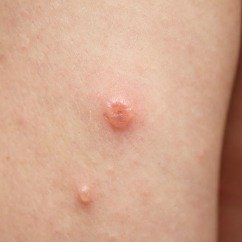- Home
- Chicken Pox
- Chicken Pox Symptoms
Chicken Pox Symptoms
Visit this
PICTURES OF RASHES PAGE
Some of the chicken pox symptoms are quite characteristic. However, many of the other symptoms of this skin problem are similar to many other skin conditions. It is important to examine the chickenpox symptoms below to ensure that the problem is actually chicken pox and not some other illness. When in doubt, contact a physician or skin doctor to properly diagnose the condition.
Signs of a Viral Illness
Chicken pox is caused by a virus and therefore, many symptoms occur that are common with viral illnesses. The symptom initially is a general ill feeling. This is often accompanied by aches and pain, tiredness, loss of appetite, possible respiratory infection, and high fever. These symptoms will be present for at least a couple of days prior to the appearance of the main chicken pox symptoms.
Chicken Pox Symptoms Itchy Rash
Afterwards, the chicken pox signs begin to appear. An itchy rash, a few red spots, or some pimple like bumps appear on the body and face. Over time these spots begin to increase in numbers and spread to other body parts. The chicken pox rash symptoms can appear on the scalp, limbs, the mucous membranes such as the mouth and inside of the nose, the genitals, eyelids, inside the ears, and basically all over the skin areas of the body. Often, covered areas of skin are affected more than exposed skin areas. New red spots on the skin can continue to develop for three to six days from the initial outbreak.
Skin Rash Turns Into Fluid Filled Blisters

The rash or red spots on the skin will develop into blisters filled with clear fluid within a few hours after they appear. This is a common chickenpox symptom. The fluid in the blisters turns cloudy and the blisters will break and scab over after a period of one to three days. The scabbing will allow the skin underneath to heal within five days on average.
The amount of blisters on the skin that forms with chicken pox varies from person to person. Some people may show very few blisters, whereas others can be completely covered, with blisters everywhere that skin is present. Some statistics on chicken pox symptoms indicate that the average number of blisters that appear with a chickenpox outbreak is approximately 300. The range is from 10 skin blisters to over 1000.
Complications from Chicken Pox
Overall, the chicken pox symptoms will be present for seven to ten days in children, but adults usually suffer from the chicken pox symptoms for a longer time period. The symptoms are milder for children and often more severe for adults and adults are more prone to the complications that accompany chicken pox.
A common complication for adults and children is a bacterial skin infection. If the exposed skin areas that are present after the blisters burst are not kept clean, then a skin infection is possible. Scratching of the itchy blisters or rash will promote an infection and this is more likely to occur with younger children. Skin infections require a visit to a doctor or dermatologist for proper diagnosis and treatment.
Other possible health complications from chicken pox include pneumonia, conjunctivitis, meningitis, encephalitis, myocarditis, or Reye’s syndrome.
When all the open skin sores have scabbed over, then a person is no longer contagious and can return to normal activities without the fear of infecting other individuals.
More chicken pox resources:
